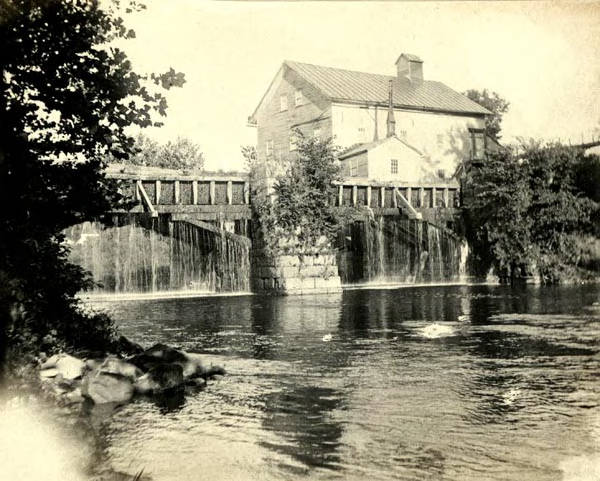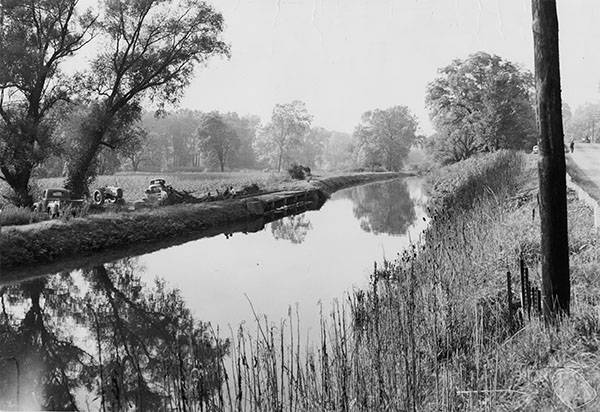Cleveland's First Infrastructure:
The Ohio & Erie Canal
from George Washington to Alfred Kelley
It is no overstatement to say that Cleveland could not have become a major commercial center had it not been for the Ohio & Erie Canal. A canal connecting Lake Erie with the Ohio River was first proposed in the late 18th century by George Washington, and by 1825 the Ohio Legislature approved the funding and construction was able to begin. When complete, the Canal travelled 308 miles through 146 lift locks, immediately transforming Cleveland into the hub of a continental transportation network connecting the western frontier with New Orleans and New York City.
Section I: Discussing a Passage
The importance of a passage from Lake Erie to the Ohio River was recognized by America's founding fathers, including surveyor and engineer George Washington, who traveled to the Ohio River valley in 1753. Once the French and Indian Wars and the American Revolutionary War had ended, Washington and others again turned their gaze toward these waterways. A selection of early maps of the area, and letters written by George Washington about an Erie to Ohio passage, are found in Section I of this site.
Section II: Planning the Canal
Concerned with the economic prosperity of their new state, Ohio business and political leaders of the late 1810s and early 1820s looked to the successful Erie Canal project in neighboring New York for a model of internal improvement. The leaders, including Cleveland's Alfred Kelley, commissioned surveyors to determine possible routes. While the surveyors charted territory and measured water levels, political leaders considered the economic interests of the populations they represented. A compendium of articles and discussions, sometimes heated, from Cleveland newspapers from 1819 through 1827 is in the process of being digitized for Section II.
Section III: Building the Canal

Prism Cross Sections, 1901.
In 1825, work began on the Ohio & Erie Canal. A massive operation of grubbing and clearing, ditch digging, and the construction of the intricate system of hydraulic locks, aqueducts and culverts, and slackwaters challenged engineers and laborers working in a mostly wilderness state. When the last section was completed, these men and women had created the first true infrastructure linking together the village of Cleveland on Lake Erie, interior towns such as Akron, Navarre, Chillicothe, and Columbus (via a feeder canal), and the town of Portsmouth on the Ohio River. In Section III, historic and modern photographs, historic diagram drawings, and excerpts from public documents of the era illustrate the engineering of the canal.
Section IV: The Canal Era
The new canal changed the natural and social landscape through which it carried passengers and cargo. Industries grew near locks, taking advantage of the power generated by water spill off. Land values rose and speculation ensued. At the Portage Summit, where a staircase of 17 locks carried boats the distance of a mile and a half to cross between the Great Lakes and Mississippi River drainage basins, Akron businesses thrived. Positioned at the juncture of Lake Erie and the Ohio & Erie Canal, Cleveland's status as an important port grew, as did its population and industry. Further inland, farmers were able to get their produce to market on a regular basis, bringing cash and luxury goods into their homes and towns. Historic photographs, maps and other images, and period advertisements offer a glimpse into canal era life in Ohio.
Cleveland's First Infrastructure is a project of Cleveland State University Library Special Collections, and was made possible by a grant from the Cleveland Section of the American Society of Civil Engineers. It seems appropriate that this exhibit, which highlights the achievement of civil engineers of the early 19th century, premiered during National Engineers Week and on the eve of the birthday of military engineer and land surveyor George Washington. We hope that this site will serve as a gateway through which people can learn about the canal, identify resources for further investigation of canal engineering and history, and find opportunities to visit preserved areas of the Ohio & Erie Canal in Ohio.





